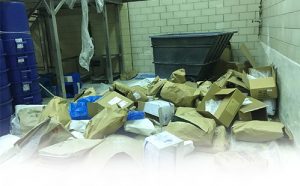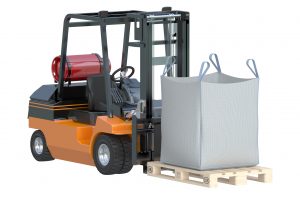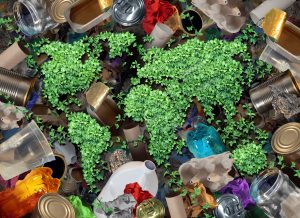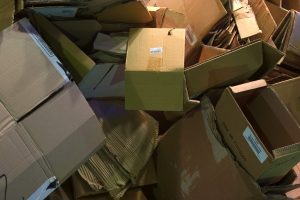by timm | Jun 13, 2017
 Bakeries, ingredient processing companies, the granary and feed industry, among many other high and medium volume industries receive content in 50 lbs. bags. The bags are generally made of paper lined or reinforced with plastic. Problems these emptied bags create are the following
Bakeries, ingredient processing companies, the granary and feed industry, among many other high and medium volume industries receive content in 50 lbs. bags. The bags are generally made of paper lined or reinforced with plastic. Problems these emptied bags create are the following
- They are made of mixed materials, i.e., plastic and paper make them unfeasible to easily and properly recycle.
- Large volumes of bags require wasted hours of physical labor & forklifts to transport bags to waste compactor, especially to stationary compactors or dumpsters.
- Getting the bags transported and compacted to reduce hauling costs can be somewhat labor intensive.
The factors affecting the disposing of these 50 lbs. bags are that the bags need to be greatly compacted and it is highly desirable that it be done where the bags are emptied.
Compacting Bags Where They are Emptied
- The person handling the bags can throw the empty bags into the compactor located at the waste’s source without moving after emptying its content into a mixer or another machine. He/she will be the last person touching the bags in the disposal process. If a machine is used to open and empty the bags it can deposit the bags directly into the compactor. The compacting process is best accomplished with the use of a continuous compactor rather than a type of baler.
Dealing with the Dust
- Frequently the residue left in the bags creates a great deal of dust, especially in some instances near where food is being processed. A dust collector can be utilized to remove the dust from the environment from the chute in which the bags are thrown passing to an enclosed chamber compactor. Or dust collection can be done from the enclosed chamber. Compacting 50 lbss. bags into large plastic bags that can be sealed for transport also reduces ambient dust.
Reducing Labor & Hauling Costs:
- Costs are reduced with fewer trips either using a pallet jack or a forklift to remove the waste filled bag from the compactor to the hauler’s container outside. The waste filled bags contain approximately 800 50 lbs. bags. Contrast this to frequent trips hauling between 100 and 200 bags loosely placed on a pallet being hauled by forklift. Reducing forklift traffic on a factory floor is always a good thing in a number of ways, such as, safety, maintenance and cost reduction.
- One meter cubes of plastic filled waste are easily manageable for transporting either in a dumpster to landfill or in a covered trailer with double stacked bags to a Waste to Energy facility. Reducing the cost of transport of waste is critical to profitability in all types of waste disposal whether it be to landfill, recycling or Waste to Energy (WtE) facilities.
KenBay has been helping many companies in a variety of industries reduce labor and hauling costs of those ubiquitous 50 lbs. bags using the original industrial rotary arm compactor, the RotoPac. Why not go to the front page of www.kenbay.com and see the RotoPac in operation? If you would like to try out a KenBay RotoPac for yourself, you can try one before you buy one. Simply pay a small fee and we’ll send one to your location. After all, you have nothing to lose but costs.
by CharlieB | Jun 12, 2017
 Plastic revolutionized our way of life. Businesses and manufacturers applied plastic to nearly every industry imaginable. The lightness of and durability of plastic improved our packaging, our construction, and how we develop new technology. And it seems like plastic use is only heading upwards. But one downside is that not enough people recycle the plastic that they use. Major manufacturing plants in particular are hesitant to deliver their plastics to a recycling station. Many of them fear that the cost of transport may is too oppressive. But fortunately, there is a workaround. If you’re worried about the cost of your plastics, here’s how to efficiently deliver them to the recycling station.
Plastic revolutionized our way of life. Businesses and manufacturers applied plastic to nearly every industry imaginable. The lightness of and durability of plastic improved our packaging, our construction, and how we develop new technology. And it seems like plastic use is only heading upwards. But one downside is that not enough people recycle the plastic that they use. Major manufacturing plants in particular are hesitant to deliver their plastics to a recycling station. Many of them fear that the cost of transport may is too oppressive. But fortunately, there is a workaround. If you’re worried about the cost of your plastics, here’s how to efficiently deliver them to the recycling station.
Whether it’s helping transport plastic to the recycling station or giving other great tips, KenBay is committed to zero waste. We offer a wide range of compactors to you for plastic and other kinds of waste. For more information, visit our website.
Off to the Recycling Station . . . But How?
The Problem with Transport
The biggest concern among manufacturers is the cost of transporting plastics. Plastic tends to expand, and doesn’t like bending from its original shape. That expansion means filling up more space on the freight truck, which then leads to a greater number of trips. Trips that you pay for, every time. Many companies attempt to cut down on these trips through compacting their plastic waste. But there’s still a problem with using something like a baler.
The Problems With Balers
Plastic wrap tends to “bounce back” or regain some of its original shape, even during a compaction process. Most balers don’t have the ability to continuously compact the waste without resorting to additional specialized equipment. They also can’t compact the plastic quickly enough to stifle the bounce back effect. As a result, the baler fills too quickly and compacts a smaller amount of plastic.
What’s the Better Solution?
The best solution is to forget using the baler and instead rely on a dependable compactor. Ideally, a compactor should feature a quick continuously rotating arm. Thus, the machine presses the plastic down so quickly and frequently it won’t have time to bounce back. Adding some heat will also help the process. Once you compact the plastic, store it inside an easily stackable bag. Now, more bags fit onto the truck, which means fewer overall trips to the recycling station. That’s where the savings come from!
KenBay Helps Your Plastics Get There
Plastics will play a major role in our effort towards renewable energy, but not if we don’t recycle them properly. One of the best ways to recycle your plastic is through our RotoPacs. RotoPacs not only are safe, easy, and offer continuous compaction, they deliver even more! They’re portable and very easy to move around your facility. You can put them right at the source of your plastic waste. That way, you reduce clutter and improve overall safety even further. If you would like to try out a KenBay RotoPac for yourself, you can try one before you buy one. Simply pay a small fee and we’ll send one to your location. Best of all, there’s no complicated process if you want to keep it for life. Simply pay the rest of the full price, and it’s yours!
by CharlieB | Jan 26, 2017
 The folks here at KenBay like to talk about recycling, zero waste, and reducing landfills. We also like to talk about saving you money! Look, we get it — you want to be environmentally conscious. Maybe you make sure to recycle in your own home and teach your children about the importance of doing so. When it comes to your business or your factory, however, finances have to come first. Hey, you’d like to recycle more, but everyone knows that with the high cost of labor, transportation, and treatment, it’s simply far more cost effective to send your waste to a landfill instead of recycling plastic. If it only cost a little cheaper, you would definitely recycle more, right?
The folks here at KenBay like to talk about recycling, zero waste, and reducing landfills. We also like to talk about saving you money! Look, we get it — you want to be environmentally conscious. Maybe you make sure to recycle in your own home and teach your children about the importance of doing so. When it comes to your business or your factory, however, finances have to come first. Hey, you’d like to recycle more, but everyone knows that with the high cost of labor, transportation, and treatment, it’s simply far more cost effective to send your waste to a landfill instead of recycling plastic. If it only cost a little cheaper, you would definitely recycle more, right?
While the cost of recycling plastic is definitely higher than dumping it, the fact remains that landfills are nothing more than a temporary solution. In fact, after decades of the practice we are only just now thinking up plausible ideas for how to make a landfill sustainable. Until those ideas become a tested and proven reality, recycling and reusing are the best methods for reducing harmful emissions and fighting against climate change. If you need some ideas for how to recycle without putting your company into the red, here are some ideas from KenBay.
Reduce Labor
A big portion of the expense of recycling plastic comes from the extra labor required for handling and transportation. Usually, you need to hire extra hands and have specialized equipment for separating and moving your recyclables. One method to reduce costs this way is to reduce the need for that kind of labor! Use a small portable compactor instead that can be easily moved and handled right at the site of your waste. Just toss the plastic in, and stop worrying about it!
Make the Most of Your Trucks
Now if every step in the recycling process could be handled on site, how easy would that be? But the reality is, you do still need to send it to another facility, which requires paying for transport costs. If you’re already paying for it, make sure you get the most of your money! Ensure that your plastic is compacted into a convenient cube shape to reduce the amount of air hauled on the truck. Remember, you are paying for volume, not weight! Through compacting as much as possible, you will always get the maximum value out of recycling plastic, and you’ll have to make fewer trips overall, saving you money!
Research and Promote New Recycling Methods
One of the best ways to reduce the cost of recycling plastic is to find and encourage innovative thinking. A company in Mexico did that last year when it discovered a new (and cheaper) method. They now have a pending patent application for their new method! Encouraging and promoting ideas like these may lead to revolutions for the way we recycle plastic, and savings for everyone!
Use KenBay for Compacting and Savings
KenBay’s line of RotoPacs provide the portable and effective cost-cutting solution that you’re looking for. We have a wide variety of compactors which can be used right on site to handle any kind of waste right then and there. If you are interested in trying our a KenBay RotoPac, we offer the opportunity to “Try it Before you Buy it.” We send you the compactor, and if you decide it’s right for you, simply pay to keep the one that we sent! And remember, for recycling plastic or any of your other waste management needs, you can do it and save money as well!
by CharlieB | Jan 7, 2017
Plastic: Helpful, but Hazardous 
The invention of plastic is one of the biggest technological advancements in the past 100 + years. The ways which plastic has made our lives more convenient are so numerous that it’s impossible to name them all here. Put simply: the way we live now would not be possible without it. At the same time, plastic poses a significant problem for the environment, namely, the fact that it does not biodegrade easily. Plastic waste is a big problem for the planet, and handling it responsibly is an absolute necessity for big manufacturing plants. KenBay is a big supporter of recycling in any form. We fully support zero waste companies committed to reducing landfills and promoting environmentally friendly handling of waste. The solution to the plastic problem is to send your plastic to a recycling facility instead of a landfill.
You probably already knew this, however. Recycling plastic is much more commonplace than it was even a few decades ago. Our children are taught to do it in elementary school. Is there any way to make recycling plastic easier, however? Actually, there is, and it can save you money as well.
Compress, Compress, Compress!
One of the big mistakes people make when recycling plastic is not breaking it down before sending it to the recycling facility. I don’t mean chemically, either, I mean actual physical pressure. Too often, people will throw their recycled bottles and milk jugs into the bin as is. You know what happens when you do that? You end up hauling mostly air, and wasting space and time making multiple trips to the recycling center. A better solution is to compress the plastic containers as much as you can and flatten them. When I was growing up, my father would have me stomp on the old milk jugs in order to get this effect. Flattening the plastic like this allows you to haul more, so you save that needed time and effort.
Choose the KenBay Way
Compressing waste is especially important for manufacturing plants who need to cut costs whenever possible. Reducing the amount of air you haul to the recycling facility is a great way to save money! And one of the best methods to compress that plastic is to use a KenBay RotoPac. You can easily toss your plastic waste inside of one, and then sit back as the RotoPac continually presses and compacts it all into an airless cube. No space wasted here, and no need for extra trips back and forth! The cubes themselves are easily stackable, meaning you also save space and money that way as well.
If you think that a KenBay RotoPac is the right fit for you, then go to our website where you can try it before you buy it. If you like what you see, then you can pay to keep the RotoPac we send you — no need to send it back at all! We think you will agree that a KenBay RotoPac will make all the difference when it comes to recycling your plastic. So this year, save money and be environmentally responsible, with KenBay!
by CharlieB | Nov 27, 2016
 Super Sacks are a truly remarkable invention. Made from a woven polypropylene fabric, these bags are incredibly durable and can handle large storage loads. Given that, they are of course a natural fit for those industries requiring heavy lifting and transportation of goods! Industries like manufacturing, environmental cleanup, and warehouse storage. There are a lot of great benefits to using these bags, but there are some difficulties as well. One of those difficulties is how to handle disposing of them. KenBay is committed to proper disposal of waste, but we also believe in taking advantage of great opportunities. And any chance to make your job easier and more efficient definitely qualifies as a great opportunity. So how can you use the Super Sacks without creating Super Trash?
Super Sacks are a truly remarkable invention. Made from a woven polypropylene fabric, these bags are incredibly durable and can handle large storage loads. Given that, they are of course a natural fit for those industries requiring heavy lifting and transportation of goods! Industries like manufacturing, environmental cleanup, and warehouse storage. There are a lot of great benefits to using these bags, but there are some difficulties as well. One of those difficulties is how to handle disposing of them. KenBay is committed to proper disposal of waste, but we also believe in taking advantage of great opportunities. And any chance to make your job easier and more efficient definitely qualifies as a great opportunity. So how can you use the Super Sacks without creating Super Trash?
Reuse and Recycle
The size and durability of these Super Sacks are like a double-edged sword. On the one hand, they’re so large and hardy that you can use them multiple times! Reusing the bag is a definite must if you want to reduce your overall waste. Between uses, make sure to inspect the bags for signs of wear and tear. Remember: Super Sacks can hold over 4000 lbs, and you definitely do not want that spilling all over your floor! Cleaning out the bags between uses is also a good idea. This helps to ensure there’s no accidental contamination.
Eventually, however, you’re going to reach a point where the sack is less Super and more Sad. That is to say, it’s fairly unusable. Do you need to haul it to the dump? Actually, no! Super Sacks are actually very easy to recycle. That’s great! You get all the benefits of using the sack and you don’t even need to worry about leaving behind a big footprint. Problem solved? Unfortunately, not quite.
The truth is, the bag is flexible, but not nearly to the same degree as a regular plastic or paper sack. The nylon material is rigid enough that it’s actually quite difficult to compact. For some this might not be a major issue. Others, however, might be concerned about financial costs. If you can’t compact the bags then you have to transport them in their original shape, which takes up more space. Or, to be more precise, the air takes up more space. You’ll be paying to transport air instead of stuff, which is wasting your money. So, is there a better way?
KenBay has Your Solution for Super Sacks!
All right, you probably saw this coming. KenBay’s RotoPacs are the perfect solution for compacting Super Sacks for recycling. Our RotoPacs are tough and a constantly rotating arm presses the material into square shapes. These squares are actually great for stacking, which means you’re not paying to haul the air! Now, you can enjoy all the benefits of using Super Sacks without worrying about the disposal. If you are interested in using KenBay’s RotoPacs for Super Sacks or your other waste disposal needs, you don’t need to wait! You can try it before you buy it. See if our RotoPacs are right for you — and most find they usually are!
by LaurenL | Oct 13, 2016
 For many businesses, a common barrier to recycling is a lack of resources. For businesses that handle recyclable cans, PET bottles, or cartons, depackaging equipment can help. While there are depackaging companies that can handle this task for you, many businesses now opt to complete the simple process themselves. Typically, these types of containers are not recycled because, in order to do so, they must first be rinsed of their liquid waste. A depackaging machine can do this task for you, while also benefiting your recycling efforts in other surprising ways. Here’s how.
For many businesses, a common barrier to recycling is a lack of resources. For businesses that handle recyclable cans, PET bottles, or cartons, depackaging equipment can help. While there are depackaging companies that can handle this task for you, many businesses now opt to complete the simple process themselves. Typically, these types of containers are not recycled because, in order to do so, they must first be rinsed of their liquid waste. A depackaging machine can do this task for you, while also benefiting your recycling efforts in other surprising ways. Here’s how.
1. No Pre-Cleaning Required
Depackaging is an integral part of waste management processes for zero waste businesses in the food industry. Thanks to this technology, they can easily separate recyclable containers from the food waste that may be inside. Food depackaging equipment varies, but popular models either unscrew bottles, or perforate cans, cartons, and bottles and then rinse whatever liquid is contained inside. This is particularly good for depackaging milk, yogurt, soft drinks, BBQ sauces and ketchup, ice cream, liquid soaps and detergents, and more.
Often, precleaning keeps people from recycling. However, with the right depackaging equipment, you can simply throw full containers into the machine. These containers are perforated or unscrewed by the machine. Then, the depackaging equipment works its magic. Food waste and other liquids inside containers are removed.
2. Recyclable Material is More Easily Managed
Not only does depackaging save you time that would otherwise be devoted to emptying containers of their waste, it can also save you money in your pursuit of zero waste. The best depackaging systems also have compaction chambers. After your containers are perforated and emptied, they are shredded or compressed tightly. With depackaging equipment that also has a high compaction rate, you’ll be able to load more recyclable waste on a single truck and make fewer trips to recycling centers or Waste to Energy plants. Because of this, you’ll spend less money on managing your recyclable waste.
3. Non-recyclable Items Can Be Repurposed
A little-known fact: depackaging equipment can also help businesses manage non-recyclable items like styrofoam or other similar materials. If your business is often left with EPS Polystyrene fish boxes and packaging, EPS dust, polypropylene packaging and insulation foam, or polypropylene (EPP) packaging, depackaging equipment can help you manage this waste. Like recyclables, these items can be emptied of any waste they may hold.Then, the foam that is left over can be condensed to create large blocks of foam. These blocks can then be sold, creating a new revenue stream for your business.
Integrate Depackaging Into Your Waste Management Process with KenBay!
If you think your waste management process could benefit from depackaging, let KenBay help you find the perfect equipment to get the job done. Our SC 2000 and SC 3000 Screw Compactors are configured for depackaging, dewatering or foam densifying. If you want to make your facility landfill free, these screw compactors can be an integral part of your waste management system. Low maintenance and heavy-duty, a KenBay screw compactor is capable of handling large throughputs of material while still maintaining a high compaction rate continuously throughout the operation.
We know that waste management can be a burden. But, with KenBay, you’ll have the tools you need to help make the job a little easier. The next time you evaluate your waste products and waste management strategy, consider integrating one of our industrial trash compactors into your processes.
Because our depackaging trash compactors will reduce the weight and size of your recyclable waste, they are a great way to cut down your waste removal costs and improve the efficiency of waste management.
Don’t let something like waste get in the way of your business operations. If you’re interested in learning more about depackaging or finding a committed consultant to help you reduce your waste, call KenBay. We can tell you more about our services, no matter what industry you’re in, or how much waste you are creating!
Photo credit: Getty Images / photka
by LaurenL | Oct 7, 2016
 When was the last time you conducted a waste audit for your business? 3 years ago? 5? Maybe, never? If that’s the case, it’s time to take another look at your waste products. Every business creates waste, that’s almost a certainty, but what is done with it, where it’s sent, and how much time, money, and resources are devoted to it can vary dramatically. All businesses handle waste management in different ways. But, the businesses that manage their waste most successfully all have one thing in common. They aren’t complacent, they aren’t stagnant, they don’t continue to do the same things they’ve done for years and years.
When was the last time you conducted a waste audit for your business? 3 years ago? 5? Maybe, never? If that’s the case, it’s time to take another look at your waste products. Every business creates waste, that’s almost a certainty, but what is done with it, where it’s sent, and how much time, money, and resources are devoted to it can vary dramatically. All businesses handle waste management in different ways. But, the businesses that manage their waste most successfully all have one thing in common. They aren’t complacent, they aren’t stagnant, they don’t continue to do the same things they’ve done for years and years.
Rather, they examine their waste products and processes with regularity. They also take a strategic approach to waste management. They examine and decide in advance how waste products will be handled, before their waste lands in a landfill!
Luckily, you can do the same for your business. If you haven’t ever evaluated your waste management processes, now is the time! Here are a few things you should consider:
Reduce, Reuse, Recycle
It may seem simple, but many businesses often forget that they can ease the burden of waste management by simply reducing the amount of waste their business creates. There are plenty of ways to reduce waste products in businesses that you should consider.
Can you recycle some of your waste? Or, can you donate excess material instead of throwing it away? Can you purchase materials in bulk to reduce packaging waste? Is it more cost effective to send your waste to a Waste to Energy plant than a landfill? We all know that reducing, reusing, and recycling are great ways to help the environment. But, in businesses, these steps can also save valuable time, resources, and ultimately money.
Evaluate Your Sources of Waste Repeatedly
If you create an effective waste management strategy, your business won’t just reduce costs associated with waste management. If fact, you might even transform manufacturing waste into profits. However, to do so, you first need to create an effective waste management plan. Then, you need to evaluate it, along with you sources of waste, repeatedly. At the start of every quarter, set aside time to take a look at the waste products in your business. Then, look for new ways to improve your waste management strategies.
Manage Your Waste Products with KenBay
We know that waste management can be a burden. But, with KenBay, you’ll have the tools you need to help make the job a little easier. The next time you evaluate your waste products and waste management strategy, consider integrating one of our industrial trash compactors into your processes.
Trash compactors like KenBay’s RotoPac are ideal waste management products for industrial settings. They allow companies to reduce the volume of their trash at a ratio of six to one. The RotoPac can handle all kinds of waste from food to recyclables, and even solid hazardous waste. Because trash compactors will reduce the weight and size of your waste, they are a great way to cut down your waste removal costs and improve the efficiency of waste management.
Don’t let something like a waste get in the way of your business operations. If you’re interested in trash compactors or finding a committed consultant to help you reduce your waste, call KenBay. We can tell you more about our services, no matter what industry you’re in, or how much waste you are creating!
Photo credit: Getty Images / humbak
by charlotte | Jul 30, 2016
 Taking care of your trash and recycling is not only a big job when running a business, but can also be a costly one. There are countless ways to reduce the costs associated with the trash and recycling handling, while simultaneously building a more sustainable business. Whether your main waste streams are in packaging or food waste there are simple ways to alleviate your removal costs.
Taking care of your trash and recycling is not only a big job when running a business, but can also be a costly one. There are countless ways to reduce the costs associated with the trash and recycling handling, while simultaneously building a more sustainable business. Whether your main waste streams are in packaging or food waste there are simple ways to alleviate your removal costs.
5 Ways to Reduce Carrying Costs of Trash and Recycling
- Educate Your Employees
The process of reducing the costs surrounding your waste management and trash and recycling hauling specifically begins with education or re-education. Once you have been caught up on all the latest policies, technologies and methodologies, begin to make a plan and spread the information throughout your company. Host informational meetings and find the people in your employ who are passionate about the cause. Use signs to help people remember what they’ve learned about your new waste management direction.
- Reduce Waste
There are many ways to reduce waste coming from your facility, and they all start with a proper audit of all your processes and the waste they produce. By auditing your waste consistently for a designated period you will discover where there are unnecessary or avoidable waste streams and know where to move from there in your goals to make less waste.
- Reduce Packaged Inventory
One waste stream you can almost always reduce no matter your industry is in packaging. Consider your purchasing practices and how you might cut down on the amount of packaging waste you produce. Packaging can come in many forms from cardboard to shrink wrap and ends up as both trash and recycling.
- Reuse Whatever You Can
There are many things that are determined waste that can be useful as opposed to discarded. Things like manilla envelopes and plastic containers can be easily stored for second use. There are also many options to sell used goods to other companies who can use or recycle them, creating yet another passive income for your company.
- Invest in a Commercial Trash Compactor
Are you looking to improve the sustainability of your business, as well as the safety of your workplace? Commercial trash compactors are the absolute best bet for achieving both of these goals for your company, as well as many more when you choose the one that is most suitable for you. With many different sizes and specialities, there are commercial trash compactors for every purpose waiting to prove their worth in investment. Not only can you improve the sustainability of your own company, but a commercial trash compactor will help you reduce the volume of waste that you are sending to your local landfill.
When companies put time, energy and money into considering how they can implement better practices for their trash and recycling handling, they are not only improving their business operations but are giving back to their community and oftentimes they’ll save money doing it. While the immediate costs and initial investments might not seem worth it, the long-term savings and improved public relations are undeniable.
If you are looking for a waste management consultant, be sure to call KenBay to learn more about our expertise.
by charlotte | Jul 15, 2016
 Using recyclable materials is about much more than reducing your waste removal costs, though that is a nice bonus. Recyclable materials promise a brighter future for our planet and the human race by reducing our use of finite resources. When companies put time, energy and money into considering how they can implement recyclable materials into their products and packaging, they are giving back to their community, and oftentimes they’ll save money doing it. While the immediate costs and initial investments might not seem worth it, the long term savings are undeniable.
Using recyclable materials is about much more than reducing your waste removal costs, though that is a nice bonus. Recyclable materials promise a brighter future for our planet and the human race by reducing our use of finite resources. When companies put time, energy and money into considering how they can implement recyclable materials into their products and packaging, they are giving back to their community, and oftentimes they’ll save money doing it. While the immediate costs and initial investments might not seem worth it, the long term savings are undeniable.
Reduce Your Spending on Recyclable Materials
- Automated Waste Reporting
End of Life regulations are only getting more strict as the government attempts to reduce the amount of waste being produced by industry. This is a trend that is being quickly adopted in the United States after many years of success in the European Union. These new regulations are encouraging companies to consider the entire lifespan of their products from their design and creation all the way through the end of their life and where they will end up when discarded. With the task of calculating recycling fees based on sales, shares, materials, weights and so forth, companies have turned to technology to help them keep track of their waste management expenses, often finding up to fifty percent savings with this approach.
- Smart Design
A large part of reducing waste management costs, especially on recyclable materials, is smart design. Maybe your company’s brand is entirely wrapped up in its packaging and the thought of changing it is overwhelming. There are many subtle things you can change in product design by using new technologies in recyclable materials that will save your fees in the long run. On the other hand, loyal customers are typically happy if you change your packaging for a good cause, because then they get to feel they are part of it.
- Incentivize Recycling
Many companies aren’t as concerned with their packaging as they are with their products themselves. In a world ruled by screens, electronics manufacturers bear a heavy burden when it comes to recyclable materials and keeping their dead products out of landfills. Companies like Apple offer end of life trade-in programs, and will even give you a small gift card for those ancient macbooks sitting around collecting dust. These programs allow them to save on fees as well as recycle old parts themselves. Customers get to feel better about where their garbage is going than simply throwing it the waste bin.
Don’t overlook the importance of implementing recyclable materials into your products and packaging. With a fresh look at your waste management practices you will find many opportunities to save money, while you might pay a little more to get the ball rolling. There are countless resources for this step towards corporate social responsibility that will not only improve the face of your brand, but will help your employees to feel part of something bigger. For more information for waste management experts on how to make a shift to a more sustainable business, give KenBay a call.
by charlotte | Jun 27, 2016
 Balers aren’t just farm tools used for hay, but they are used throughout other industries for things like paper, cardboard, plastic and even textiles. They are one of the most common backroom tools in a retail setting, and keep stock rooms free from the clutter of empty boxes, while helping clothing donation centers efficiently store and ship clothes. If you are looking for a way to better manage waste in your facility, be it boxes or otherwise, balers come in a number of sizes with various purposes and are an affordable solution to help you get more organized and lower your waste removal costs.
Balers aren’t just farm tools used for hay, but they are used throughout other industries for things like paper, cardboard, plastic and even textiles. They are one of the most common backroom tools in a retail setting, and keep stock rooms free from the clutter of empty boxes, while helping clothing donation centers efficiently store and ship clothes. If you are looking for a way to better manage waste in your facility, be it boxes or otherwise, balers come in a number of sizes with various purposes and are an affordable solution to help you get more organized and lower your waste removal costs.
Balers aren’t Too Big for Your Backroom
Many people avoid investing in equipment like balers because they assume they will take up far too much room. While some balers can be as large as 12 square feet at their base, there are many smaller models that you will easily be able to make room for, especially considering the fact that they will reduce the size of your waste at a ratio of six to one. Balers aren’t space consuming, they are space creating. Don’t fall for this common misconception and be held back from an investment that will end up showing returns in what can happen in just a matter of months.
Balers for Everything
Whether you’re in a retail store with thousands of boxes that pile up each week, or a food and beverage setting with plastic recyclables or food waste that needs compacting, balers are the perfect solution. A self-contained compactor is perfect for any setting in which wet waste is unavoidable and a plastic bag is available instead of using wire for tying bales. Leakage will always be controlled, and you can even buy biodegradable bags to contribute to your zero landfill initiative should that be your goal. Even if you have waste that is large and awkwardly sized like furniture, you will be able to find balers strong enough for the job. Don’t let your waste cans overflow with unruly items piling them up far sooner than they ought. Make use of balers to do this awkward, time-consuming and often messy waste management job.
Save Money with Balers
Compacting and baling your waste is one of the easiest ways to save money on your waste management costs. More compact waste means you can have it removed from your premises less frequently, saving you money on transportation. Furthermore if you’re recycling a significant amount of plastic, metals or paper and cardboard, you can actually make money selling sorted bales back to the recycling company. This can end up being quite a lucrative stream of income for your business if you’re producing enough waste.
Investing in equipment like balers is one of the best steps to take in rethinking your waste management practices. Ideally you will take time to consider each step in your process to see how you can minimize waste and maximize efficiency, and maybe even partner with a waste management expert to see you through the process and recommend the best equipment for the task. Call KenBay to learn more about how we can help take this step in improving your business!
 Bakeries, ingredient processing companies, the granary and feed industry, among many other high and medium volume industries receive content in 50 lbs. bags. The bags are generally made of paper lined or reinforced with plastic. Problems these emptied bags create are the following
Bakeries, ingredient processing companies, the granary and feed industry, among many other high and medium volume industries receive content in 50 lbs. bags. The bags are generally made of paper lined or reinforced with plastic. Problems these emptied bags create are the following

 Plastic revolutionized our way of life. Businesses and manufacturers applied plastic to nearly every industry imaginable. The lightness of and durability of plastic
Plastic revolutionized our way of life. Businesses and manufacturers applied plastic to nearly every industry imaginable. The lightness of and durability of plastic  The folks here at KenBay like to talk about
The folks here at KenBay like to talk about 
 Super Sacks are a truly remarkable invention. Made from a
Super Sacks are a truly remarkable invention. Made from a 
 When was the last time you conducted a waste audit for your business? 3 years ago? 5? Maybe, never? If that’s the case, it’s time to take another look at your waste products. Every business creates waste, that’s almost a certainty, but what is done with it, where it’s sent, and how much time, money, and resources are devoted to it can vary dramatically. All businesses handle waste management in different ways. But, the businesses that manage their waste most successfully all have one thing in common. They aren’t complacent, they aren’t stagnant, they don’t continue to do the same things they’ve done for years and years.
When was the last time you conducted a waste audit for your business? 3 years ago? 5? Maybe, never? If that’s the case, it’s time to take another look at your waste products. Every business creates waste, that’s almost a certainty, but what is done with it, where it’s sent, and how much time, money, and resources are devoted to it can vary dramatically. All businesses handle waste management in different ways. But, the businesses that manage their waste most successfully all have one thing in common. They aren’t complacent, they aren’t stagnant, they don’t continue to do the same things they’ve done for years and years.  Taking care of your trash and recycling is not only a big job when running a business, but can also be a costly one. There are countless ways to reduce the costs associated with the trash and recycling handling, while simultaneously building a more sustainable business. Whether your main waste streams are in packaging or food waste there are simple ways to alleviate your removal costs.
Taking care of your trash and recycling is not only a big job when running a business, but can also be a costly one. There are countless ways to reduce the costs associated with the trash and recycling handling, while simultaneously building a more sustainable business. Whether your main waste streams are in packaging or food waste there are simple ways to alleviate your removal costs.  Using
Using  Balers
Balers